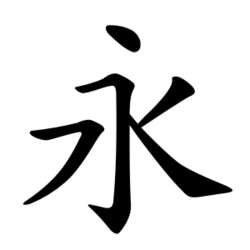永字八法
Chinese
| forever; always; perpetual(ly) | letter; symbol; character letter; symbol; character; word |
eight | law; method; way law; method; way; Buddhist teaching; Legalist; France (abbrev.) | ||
|---|---|---|---|---|---|
| trad. (永字八法) | 永 | 字 | 八 | 法 | |
| simp. #(永字八法) | 永 | 字 | 八 | 法 | |
Pronunciation
Japanese
| Kanji in this term | |||
|---|---|---|---|
| 永 | 字 | 八 | 法 |
| えい Grade: 5 |
じ Grade: 1 |
はち > はっ Grade: 1 |
ほう > ぽう Grade: 4 |
| kan’on | goon | kan’on | goon |

永字八法 (eiji happō): a demonstration of the Eight Principles of Yǒng with all eight strokes.
Etymology
From 永字 (eiji, “永 kanji”) + 八 (hachi, “eight”) + 法 (hō, “principle”).
The hō changes to pō as an instance of rendaku (連濁)..
Noun
永字八法 • (eiji happō) ←えいじはつぱふ (eizifatupafu)?
- (calligraphy) the Eight Principles of Yǒng
- 側 (soku) or 点 (ten, literally “point”), the first
- 勒 (roku), the second
- 努 (do), the third
- 趯 (teki) or 跳ね (hane, literally “jump”), the fourth
- 策 (saku), the fifth
- 掠 (ryaku) or 左払い (hidari harai, literally “left sweep”), the sixth
- 啄 (taku), the seventh
- 磔 (taku), 捺 (natsu), or 右払い (migi harai, literally “right sweep”), the eighth
References
- Matsumura, Akira, editor (2006), 大辞林 [Daijirin] (in Japanese), Third edition, Tōkyō: Sanseidō, →ISBN
This article is issued from Wiktionary. The text is licensed under Creative Commons - Attribution - Sharealike. Additional terms may apply for the media files.
